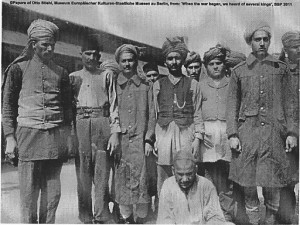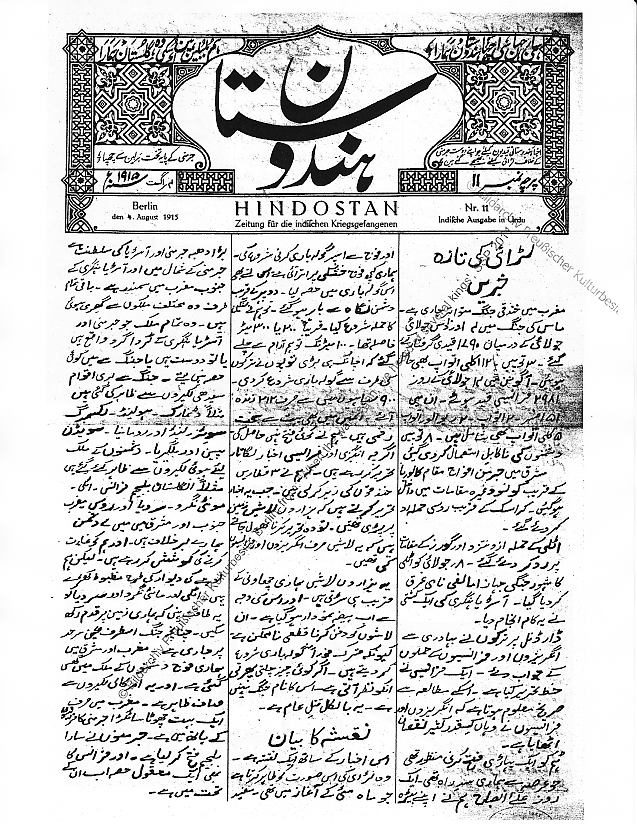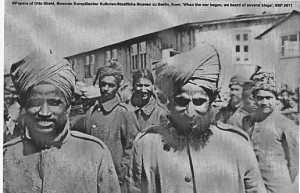Among recent publications on the Indian role in the First World War, one of the most important is a collection entitled When the War Began We Heard of Several Kings: South Asian Prisoners in World War I Germany, by Franziska Roy, Heike Liebau and Ravi Ahuja (Social Science Press, 2011). §
 The volume has an excellent introduction, in which some very pertinent questions are asked about why Indian soldiers and sailors have suffered such neglect in public memory (not for nothing has it been said that ‘more words have been written about the British war poets than about all the non-white troops put together’.)¶
The volume has an excellent introduction, in which some very pertinent questions are asked about why Indian soldiers and sailors have suffered such neglect in public memory (not for nothing has it been said that ‘more words have been written about the British war poets than about all the non-white troops put together’.)¶
What makes this collection especially valuable is that it deals with some very unusual archival materials – data collected in German prisoner of war camps.

Thousands of Indian soldiers and sailors were captured by German forces during the war.
They were imprisoned primarily in two camps, in the towns of Zossen and Wünsdorf, near Berlin: one was known as the ‘Weinberg Camp’ and the other as ‘Halfmoon Camp’.
Few cities in the world had as great a concentration of scholars as Berlin and the camps did not escape their attention. Through the war years the ‘Indian camps’ and their inmates were extensively studied by teams of linguists, anthropologists,
ethnomusicologists, legal scholars and the like.
The Royal Prussian Phonographic Commission also sent teams to the camps, to make recordings of the prisoners’ voices. This resulted in an extensive audio archive, which is now housed in Berlin’s Humboldt University.
The book’s title is taken from a recording of a Sikh soldier by the name of Sib Singh: it was made at the Wünsdorf camp in December 1916: “The German Emperor is very wise. He wages war against all kings. When the war is over, many stories will be printed. In India the Englishman rules. We had no knowledge of any other king. When the war began, we heard of several kings.”
Perhaps the most remarkable thing about this book is that it comes with a CD. This permits us, literally, to listen to the lost voices of these soldiers and sailors: we can actually follow Sib Singh as he chants in Punjabi: ‘German badshah bahut akalmaand hai, sab badshahan naal larai karda hai, jis vakht larai hategi saam kisse bahut chhapange aur India me Angrez badhsah hai aur sannu kisi badshahan da pata nahi si.’
There is a touching song sung in Nepali, by a Gurkha soldier called Jasbahadur Rai. I would have liked to post it here, but unfortunately my technical skills were unequal to the task.
The CD also includes other invaluable materials, among them copies of the camps’ newspaper, ‘Hindostan’, in Hindi
and in Urdu;
a few of the prisoners’ paintings, such as this one;
and a spreadsheet that lists the names of the thousand or so inmates whose voices were recorded. The spreadsheet includes some other details too: for example, age, education, place of birth, caste and language. It suggests that most of the prisoners were in the late-twenties to middle-thirties age range.
But one fifty-year-old is also listed – a ship’s steward from Calcutta by the name of Mohammad Hussein. He is one of those whose voice can be heard on the CD. Speaking in Bangla he tells us: amra kolikatar manush… amra gorib manush – ‘we are from Kolkata – we are poor men…‘.
The youngest soldiers on the list were nineteen. Many were probably the sons of sepoys for several seem to have studied in regimental schools, among them one Jit Singh, a Gurkha, who had studied in Almora, and Piar Singh, also a Gurkha, who had been schooled in Darjeeling.
The great majority of the listed soldiers were from the north of the subcontinent: from Garhwal, Kumaon, Punjab, the North-West Frontier and of course Nepal. The lascars on the other hand were largely from Calcutta. The overwhelming majority of the soldiers were farmers. In the ‘caste’ column the entries that occur most commonly are Gurung, Thapa, Rai and Limbu for the Gurkhas; Burathoki (Magar), Dudumdara, Thakur and Brahmin for the Hindus; Chakkar, Chawan, Pathan and ‘Balutsch’ for the Muslims. No castes are given for the Sikhs – they are listed simply as ‘Sikh’. There is also a lone Christian from Calcutta by the name of Albert Newton. He had studied in missionary school and was employed as a ‘Captain’s Boy’ on a ship.
Germany’s wartime leadership perceived the camps as a possible means of furthering some of their war aims. Some emigre Indian revolutionaries, like Lala Har Dayal and Virendranath Chattopadhyay, also sought to propagate their views in the camps.
What did the inmates make of their efforts? One of the strengths of When The War Began is that this complicated issue is addressed with great care.
When The War Began is an immensely valuable contribution to our knowledge of the Indian experience of the First World War. I strongly recommend it to everyone with an interest in that era. Fortunately it is easily available on Amazon and Flipkart.
_____________________________________________________
§ I would like to thank the authors for helping to obtain permision for the use of the pictures that are posted here.The credits are as follows: Photos: Otto Stiehl, Repros: Ute Franz-Scarciglia, Copyright: Museum Europäischer Kulturen – Staatliche Museen zu Berlin.
¶ Gail Braybon, quoted by Santanu Das in his introduction to Race, Empire and First World War Writing, CUP, 2011







